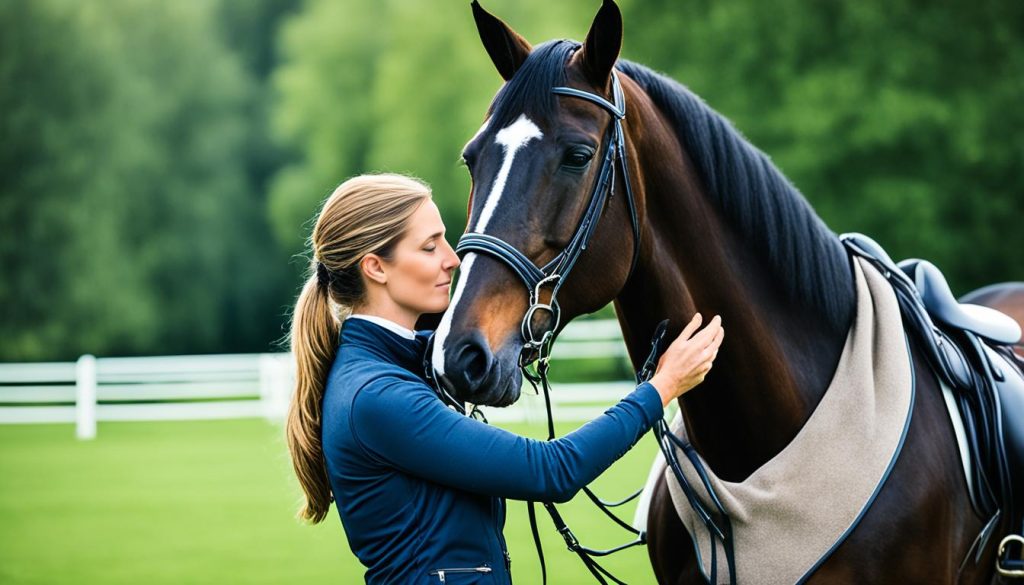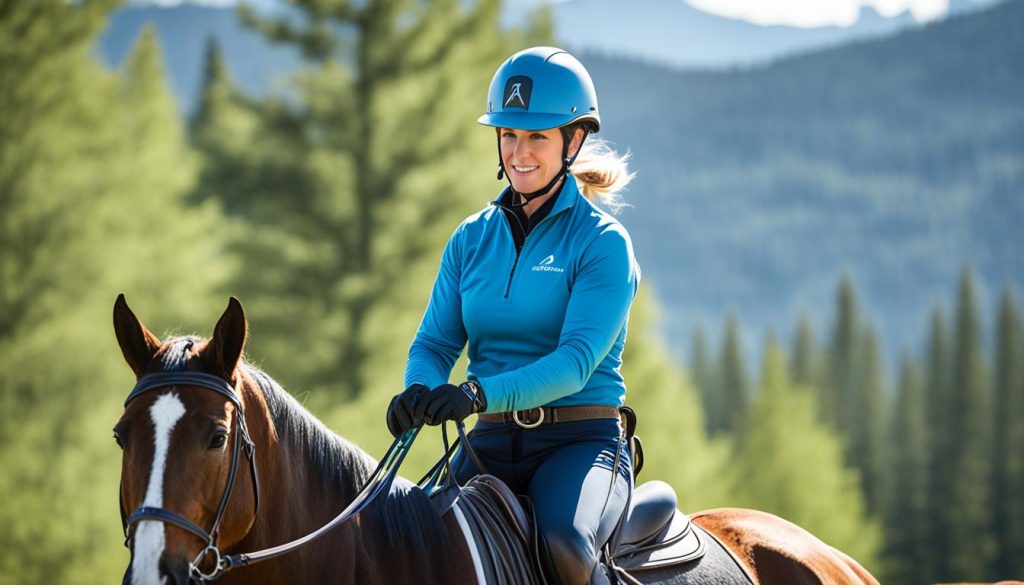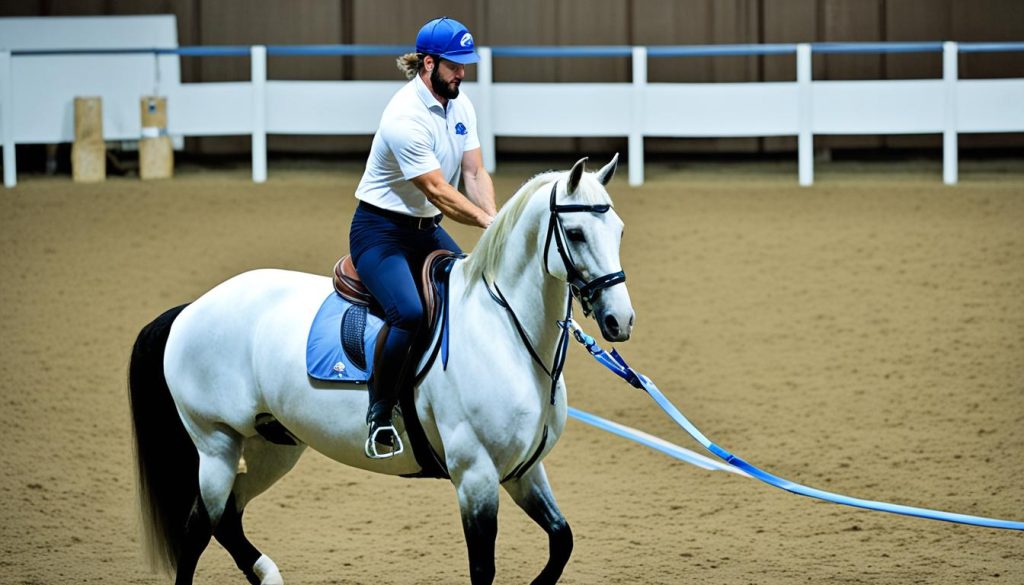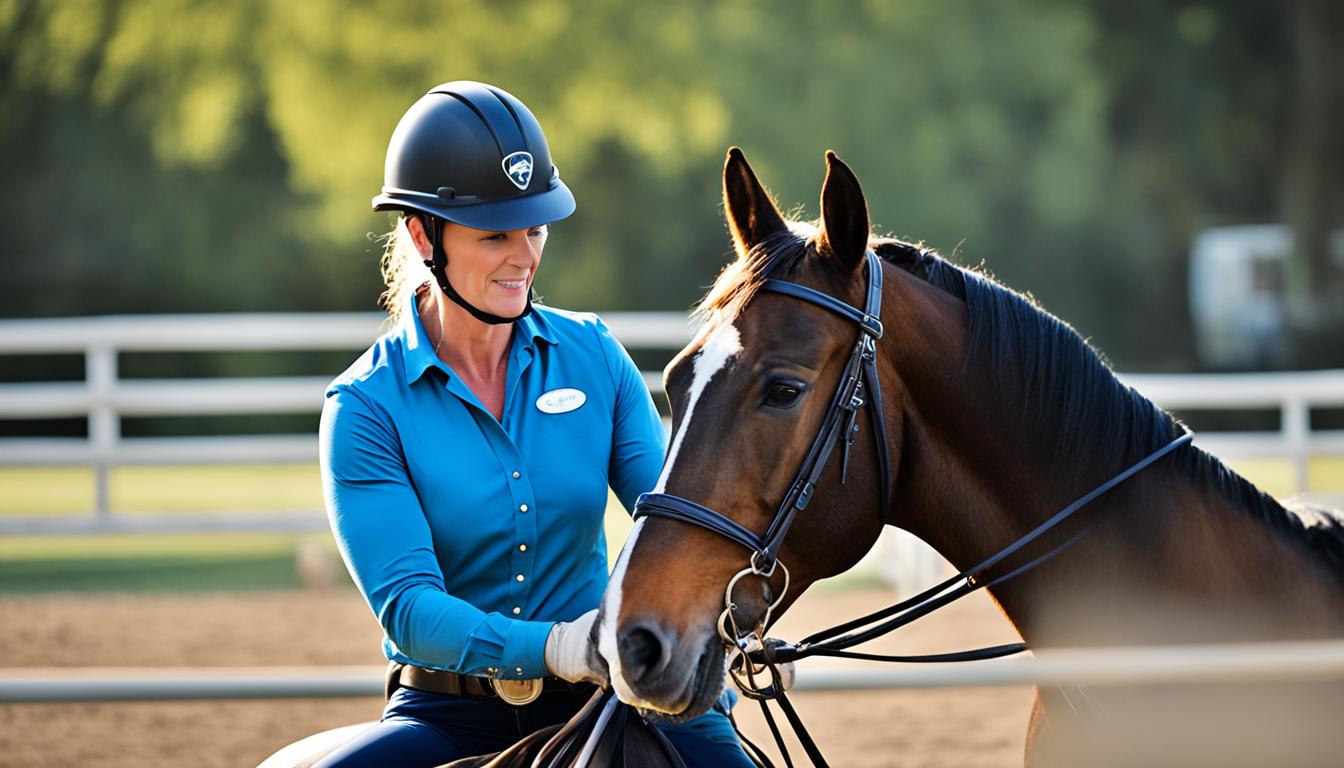“The essential joy of being with horses is that it brings us in contact with the rare elements of grace, beauty, spirit, and freedom.” – Sharon Ralls Lemon
Transitioning from groundwork to liberty in horsemanship is a transformative journey that allows you to unlock the true potential of your bond with your horse. It is a path that leads to grace, beauty, spirit, and freedom. By incorporating specific groundwork exercises, you can establish trust, deepen your relationship, and elevate your horsemanship skills to new heights.
Establishing Trust through Groundwork
Groundwork exercises are a crucial component of building trust and communication with your horse. By establishing a solid foundation through leading exercises, yielding exercises, and horse desensitization exercises, you can create a strong bond and develop mutual understanding.
Leading Exercises: Encouraging Trust and Responsiveness
Leading exercises involve guiding your horse through various obstacles, encouraging them to follow your cues and trust your guidance. This exercise not only promotes trust but also develops responsiveness and obedience. By confidently leading your horse through different challenges, you establish yourself as a leader and earn your horse’s trust.
Yielding Exercises: Promoting Body Awareness and Respect
Yielding exercises focus on teaching your horse to yield hindquarters and shoulders, promoting body awareness and respect. When your horse can yield their hindquarters and move their shoulders, they become more responsive to your cues and commands. This exercise enhances communication and establishes boundaries, further strengthening the bond between you and your horse.
Horse Desensitization Exercises: Calmness and Focus
Horse desensitization exercises involve introducing your horse to new objects and sounds to help them remain calm and focused. By gradually exposing your horse to different stimuli, such as plastic bags, tarps, or loud noises, you teach them to stay relaxed and attentive. This exercise is essential for reducing spookiness and building confidence in various environments and situations.
“Groundwork is the key to building trust and understanding with your horse. Through leading exercises, yielding exercises, and desensitization exercises, you create a solid foundation for a harmonious partnership.” – John Lyons
To illustrate the importance and effectiveness of these exercises, let’s take a look at the following table:
| Exercise | Benefits | How to Perform |
|---|---|---|
| Leading Exercises | Develops trust, responsiveness, and obedience | Guide the horse through various obstacles, gradually increasing the difficulty |
| Yielding Exercises | Promotes body awareness, respect, and responsiveness | Teach the horse to yield hindquarters and move shoulders with light pressure |
| Horse Desensitization Exercises | Reduces spookiness, builds confidence, and improves focus | Introduce the horse to new objects and sounds in a controlled and gradual manner |
Developing Communication through Groundwork
Groundwork exercises are not only beneficial for establishing trust and building a strong bond with your horse but also for enhancing communication between you and your equine partner. By incorporating horse lunging exercises into your groundwork regimen, you can improve balance, flexibility, and responsiveness in your horse while promoting a deeper connection.
Horse lunging exercises involve guiding your horse in a circular motion at varying speeds and directions on a long line or lunge line. This exercise requires your horse to not only listen and respond to your verbal and physical cues but also maintain balance and focus.
Lunging is an effective way to improve your horse’s responsiveness and strengthen your communication skills, especially when you can’t work with them directly. This exercise allows you to observe and communicate with your horse from a distance, reinforcing your bond and trust even when you’re not in close proximity.
Horse liberty work takes the relationship between you and your horse to the next level by eliminating physical restraints. Liberty work involves working with your horse without a halter, bridle, or any other form of physical attachment. Instead, you rely on clear communication, body language, and mutual understanding to achieve the desired results.
During liberty work, you and your horse engage in a dance-like partnership, with movements and cues flowing seamlessly between you. This type of groundwork not only deepens your bond but also develops trust, respect, and mutual understanding. With horse liberty work, you can establish a true connection based on trust and communication.
By incorporating both horse lunging exercises and liberty work into your groundwork routine, you’ll see remarkable progress in your ability to communicate with and understand your horse. These exercises promote responsiveness, trust, and cooperation, paving the way for a harmonious partnership. Take the time to engage in these exercises regularly, and you’ll witness the transformative power of developing communication through groundwork.
Patience and Consistency in Groundwork
When engaging in horse groundwork, two essential qualities are patience and consistency. By prioritizing these attributes, you can develop a strong bond and effective communication with your horse while laying the foundation for a lasting partnership. Groundwork exercises require time and repetition to establish trust, respect, and understanding between you and your horse.
“Patience is key when working with horses. They thrive on consistency and repetition, and it takes time for them to understand what we are asking of them. By staying patient and allowing them to learn at their own pace, we build trust and create a strong partnership.”
– Mary Smith, Professional Horse Trainer
Consistency is equally important in horse groundwork. By maintaining consistent training practices, you provide clear expectations for your horse, helping them understand the tasks at hand. This consistency ensures that you and your horse are on the same page and fosters effective communication throughout the training process.
It’s crucial to conclude each groundwork session on a positive note, rewarding your horse for their efforts. This positive reinforcement reinforces their understanding and encourages their motivation for future sessions. Whether it’s through verbal praise, physical affection, or a small treat, acknowledging their progress helps strengthen their bond with you.
By dedicating yourself to the process of groundwork and maintaining patience and consistency, you will witness significant progress in your horsemanship journey. Remember that each horse is unique, and their progress may vary. Be patient with yourself and your horse as you navigate this journey together.
Benefits of Patience and Consistency in Groundwork
Practicing patience and consistency in your horse groundwork sessions offers several benefits:
- Building Trust: Patience and consistency build trust between you and your horse, as they understand that you are a reliable and fair leader.
- Effective Communication: By consistently asking for specific tasks and rewarding their efforts, your horse learns to respond to your cues and understands your expectations.
- Strong Bond: The patient and consistent approach helps create a strong bond between you and your horse, fostering a deeper connection and understanding.
- Confidence and Relaxation: A patient and consistent training routine helps your horse feel more confident and relaxed, leading to better performance and a calmer demeanor.
Remember, patience and consistency are key elements in developing a solid foundation of trust, respect, and communication in your horse groundwork. Embrace the process, celebrate the small victories, and enjoy the journey towards a deeper bond with your equine partner.

The Fundamentals of Groundwork
The Clinton Anderson Method emphasizes the importance of laying a solid foundation through the Fundamentals of groundwork. These fundamental exercises are essential for developing a strong bond, trust, and respect with your horse. By implementing these techniques, you can establish a solid groundwork routine that sets the stage for success in all areas of horsemanship.
Roundpenning
Roundpenning is the initial step in the Clinton Anderson Method. It involves working with your horse in a round pen, teaching them to move their feet in different directions. This exercise helps establish respect and responsiveness, as well as improve your horse’s focus and attention. Through roundpenning, you’ll learn to effectively communicate with your horse and establish yourself as a trusted leader.
Desensitizing Exercises
Desensitizing exercises are crucial for helping your horse overcome fears and develop trust. This involves introducing your horse to various objects and stimuli, such as the lead rope and Handy Stick, in a controlled and gradual manner. By desensitizing your horse, you can teach them to remain calm and focused during training and other activities, ultimately strengthening the bond between you.
Yielding Exercises
Yielding exercises focus on teaching your horse to respond to pressure and yield their hindquarters and forequarters. These exercises promote responsiveness, respect, and control. By practicing yielding exercises, you can improve your horse’s overall body awareness, suppleness, and flexibility. This increased responsiveness transfers to all areas of horsemanship, making it an essential skill to develop.
By incorporating the Fundamentals of groundwork, including roundpenning, desensitizing exercises, and yielding exercises, you can lay a solid foundation for a successful partnership with your horse. These exercises promote trust, respect, and effective communication, setting the stage for further advancement in your horsemanship journey.

| Exercise | Description |
|---|---|
| Roundpenning | Working with your horse in a round pen to establish respect and responsiveness |
| Desensitizing Exercises | Introducing your horse to various objects and stimuli to help them overcome fears and develop trust |
| Yielding Exercises | Teaching your horse to respond to pressure and yield hindquarters and forequarters for improved responsiveness and control |
Backing Up and Flexing Exercises
When it comes to building trust and improving your horse’s obedience, backing up and flexing exercises are essential components of your groundwork routine. These exercises not only teach your horse to respond to pressure but also enhance their softness and suppleness for under-saddle work.
Backing up exercises are instrumental in teaching your horse to back away respectfully while remaining responsive to your cues. There are various methods you can use to achieve this, such as tapping the air behind your horse or applying steady pressure on their chest. Consistent practice with backing up exercises promotes lightness and obedience, reinforcing the bond between you and your horse.
Flexing the head and neck is another crucial exercise that promotes horse softness and flexibility. By gently guiding your horse’s head and neck to the left and right, you encourage them to yield to the pressure and become supple. These exercises from the ground lay the foundation for improved performance under saddle, as your horse becomes more responsive to rein aids and transitions.
Remember, consistency is key when incorporating backing up and flexing exercises into your horsemanship routine. Regular practice will help your horse develop the necessary physical and mental flexibility, leading to improved overall performance and a deeper connection with your equine companion.
Expert Tip:
“Incorporate the backing up and flexing exercises into your daily groundwork sessions. Start with gentle pressure and gradually increase the difficulty as your horse becomes more confident and responsive. Always reward your horse’s efforts and stay patient throughout the process.”
By incorporating backing up and flexing exercises into your groundwork routine, you lay a solid foundation for your horse’s softness training. These exercises promote responsiveness, obedience, and suppleness, preparing your horse for a successful partnership both on the ground and under saddle.
Lunging for Respect and Yielding the Hindquarters
Incorporating lunging exercises and hindquarters yielding into your groundwork routine can have transformative effects on your horsemanship. These exercises promote body control, respect, and deepen the understanding between you and your horse.
1. Lunging for Respect
Lunging for Respect exercises focus on sending your horse energetically around you on a circle. This exercise improves responsiveness and respect by encouraging your horse to tune into your cues and follow your direction.
A proper lunge involves controlling the speed, rhythm, and direction of your horse’s movement. Start with a lunge line and a lunge whip, positioning yourself safely in the center of the circle. Gradually increase the horse’s energy level and encourage them to move forward, backward, and change direction based on your cues. This exercise helps your horse develop balance, flexibility, and overall responsiveness.
Avoid rushing the process and ensure that you and your horse are comfortable with each step before progressing. With time and consistency, lunging for respect exercises can improve your horse’s athleticism, obedience, and trust in your leadership.
2. Hindquarters Yielding
Yielding the hindquarters is another essential exercise for promoting respect and communication with your horse. This exercise teaches your horse to disengage their hindquarters and yield to minimal pressure, enhancing their overall body control and responsiveness.
To perform hindquarters yielding, position yourself on the same side as your horse’s shoulder. Apply gentle pressure on the horse’s hip with your hand or a training aid, such as a dressage whip. The goal is to ask the horse to move their hindquarters away from the pressure and cross their hind legs as they pivot on the forelegs.
As your horse responds to the pressure and begins to yield, release the pressure and reward them with a soft voice or a gentle stroke. Repeat this exercise on both sides of your horse to ensure balanced development.
Hindquarters yielding exercises promote body awareness, flexibility, and responsiveness. They also enhance your horse’s ability to maintain straightness and engage their hind end, which is crucial for balanced movement and effective riding.
Remember to approach lunging and hindquarters yielding exercises with patience, consistency, and respect for your horse’s physical abilities. These exercises should be introduced gradually and built upon as your horse gains confidence and proficiency.

| Lunging for Respect | Hindquarters Yielding |
|---|---|
| Improves responsiveness | Enhances body control |
| Encourages respect | Promotes flexibility |
| Develops balance | Improves hind end engagement |
| Aids in trust-building | Fosters obedience |
Conclusion
Transitioning from groundwork to liberty is a significant milestone in horsemanship. By incorporating specific exercises and techniques, you can foster trust, improve communication, and elevate your relationship with your horse. Groundwork provides a solid foundation for building trust, while liberty work takes the bond to a new level of connection and understanding.
Throughout this journey, patience and consistency are key. Dedicate yourself to the process, rewarding your horse’s efforts, and maintaining consistent training practices. Remember to prioritize the well-being and happiness of your horse at all times.
As you explore liberty horse handling, continue to deepen your understanding and refine your liberty exercises for horses. This journey is one of mutual respect, trust, and freedom. Embrace the opportunity to develop a harmonious partnership with your horse and enjoy the wondrous world of liberty.
